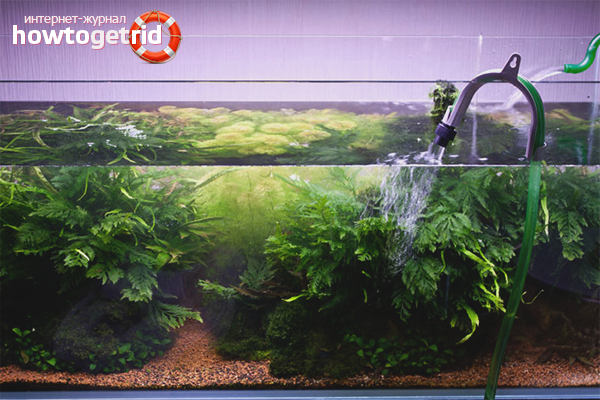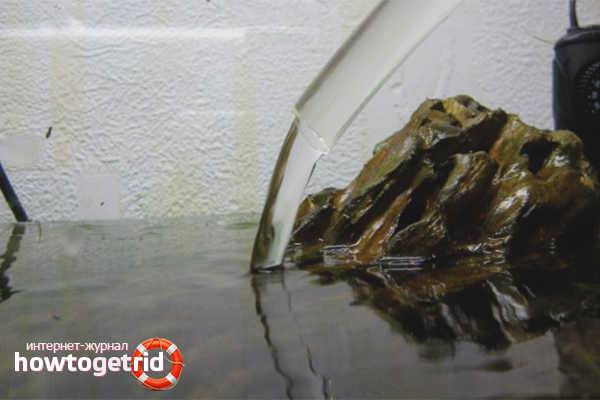The content of the article
Even before the aquarium appeared in the house, many caring owners think about the conditions of the underwater world. And one of the main questions is the frequency of water changes in the aquarium. Here, even the most experienced aquarists disagree. Someone changes water twice a month, another boastfully says that he does not change water at all and everything is fine. In fact, this question is very important and requires finding the optimal balance.
Do I need to change the water in the aquarium
The aquatic environment is a system of interaction between plants, fish and organic compounds. Over time, beneficial bacteria grow in the aquarium, adapting the aquatic environment to living organisms in it. If too often changing the water or, even worse, replacing it completely, beneficial bacteria and organisms will not be able to populate the water again and again. Water will remain dead, and living organisms will begin to die. This leads to an excessive love of "cleanliness" and the frequent change of water in the aquarium.
Along with this, one should not neglect the change of water in the aquarium and abandon this procedure completely. By supporting life in a closed water system, we are trying to bring life in the aquatic environment closer to natural conditions. And on the earth there is not a single reservoir in which at least one small river or brook would not flow. If the circulation of water in the reservoir is disturbed, if the living environment does not receive an influx of fresh water, the system sooner or later dies. The fact is that pieces of decomposed plants, residual fish, and other organic waste poison the water, leaving a huge amount of toxins and nitrates in it. Over time, the concentration of these poisons increases, the immunity of fish decreases. This will sooner or later lead to illness or even death of the inhabitants of the aquarium. Therefore, in order to reduce the concentration of toxins, water must be partially changed. That is, we remove part of the "poisoned" water, clean the aquarium, and then add clean water. Only in this way can you maintain the normal life of all organisms in a small underwater world.
How often do you need to change the water in the aquarium
By the word “change” we mean a partial change of water in the aquarium. Typically, part of the replacement water is 10-15% of the total volume. In some cases, the percentage can go up to 20, but should not exceed 25%. In this case, the aquatic system will recover much longer. But the question is how often to change the water in the aquarium? How many times a month or a year does water need to be changed so as not to disturb the aquatic ecosystem? Each owner is guided by their own conditions for keeping fish, the size of aquatic inhabitants, the age of the aquarium. We will determine the average indicators, and focus on the time of settlement of the aquarium.
- If you first populated the aquarium with fish and plants, the water system is just starting its life. In this case, you need to leave the aquarium alone for at least several months. During this time, biological balance will return to normal, the fish will begin to settle in, and the plants will take root. The water in the new aquarium does not need to be changed the first three months.
- Three months later, when you notice the formation of the first “garbage” at the bottom of the aquarium, you can replace a small part of the water with fresh. To do this, drain about 10% of the total volume of the aquarium, clean the glass and bottom, and then pour in new fresh water. Such a change of water should be done once every two weeks, until the aquatic environment in the aquarium becomes completely ripe.
- Six months after the start of life, the aquatic ecosystem is considered mature.The water in such an aquarium needs to be changed once a month, changing 20% of the total liquid volume.
- A year after the launch of the aquatic ecosystem, the aquarium is considered old. That is, the system has grown so large that it is quite difficult to unbalance it. In this case, the water in the aquarium must be changed every 2 weeks, about 25% of the total volume. In this case, do not forget to do a thorough cleaning of the aquarium bottom. By regularly changing the water and cleaning the bottom, you can maintain the water system for many years, avoiding the global cleaning of the aquarium.
Over time, the owner of the aquarium itself begins to understand the need for a water change, focusing on the degree of contamination of the aquarium, the condition of the fish, and densely populated plants.
How to change the water in the aquarium
In order for the fish in the aquarium to feel good, the plants were not damaged, and all the garbage was removed, cleaning and replacing the water in the ecosystem must be done correctly. So, how to replace the water in the aquarium?
- To begin with, we calculate the age of our aquarium and, according to the scheme, remove part of the water (10-25%).
- We do not drain the removed water, but leave it in a small cup. It needs to rinse filters and other equipment. This is done on purpose so as not to rinse vital parts under running water.
- After that, rinse the walls of the aquarium with a clean rag. The cloth should be tiny so as not to catch a fish or plant with its volume. In addition, the rag should not come into contact with soap formulations, even in the past. The ingress of aggressive detergents (even in small quantities) into the water is fraught with disease and even death of the inhabitants. If some walls of the aquarium are not cleaned with a rag, you can try to scrape off the dirt with a simple blade. After such cleaning, the glass will become completely transparent.
- Do not forget to cut off part of too thick plants, as well as remove painful and broken processes.
- It is time to clean the ground. In any pet store you can find a siphon - a device for cleaning the soil from any organic sewage. One end is placed in the aquarium, and the other remains outside. With the help of a powerful stream of water, all unnecessary is sucked into the apparatus, leaving the soil crystal clear.
- If necessary, it's time to rearrange decorative elements, transplant plants and other transformations.
- And only after the "general cleaning" you can fill in fresh water in the amount that was removed from the aquarium. You can pour a little more (given the evaporation). However, remember that simple tap water cannot be poured into the aquarium. Water must first be defended for several days in an open container. The fact is that tap water contains a huge amount of air bubbles in its composition. If these small bubbles get into the water, they may be in the body of the fish. If the smallest air bubbles get into the blood vessels of the fish, it will develop a gas embolism, which can lead to serious illness and even death. That is why water should first be defended for at least 5 days. When pouring water into the aquarium, do not completely drain the water - chlorine and other settled harmful substances remain at the bottom of the container. For the upholding of large volumes of water, you can use plastic construction containers.
This algorithm of actions will help you replace water correctly, without harm to living microorganisms.
How to replace aquarium water completely
You need to understand that the complete replacement of water in the aquarium is the launch of a new aquarium. The fish need to be resettled in a jar of water, the aquarium should be completely emptied, washed and disinfected with antiseptics. Then comes the sorting of infected fish and plants. Sometimes, in order to distinguish a sick fish from a healthy one, a veterinarian may be required. Only healthy organisms populate a clean aquarium to prevent re-infection.
Aquarium is a real underwater world, with its own rules, laws and beauties. And for this world to be in a biological balance, it needs competent and regular care. On the issue of changing water, one must adhere to the golden mean - it is very important here not to overdo it and at the same time not to neglect cleanliness.
Video: tips for keeping and arranging the aquarium











Submit